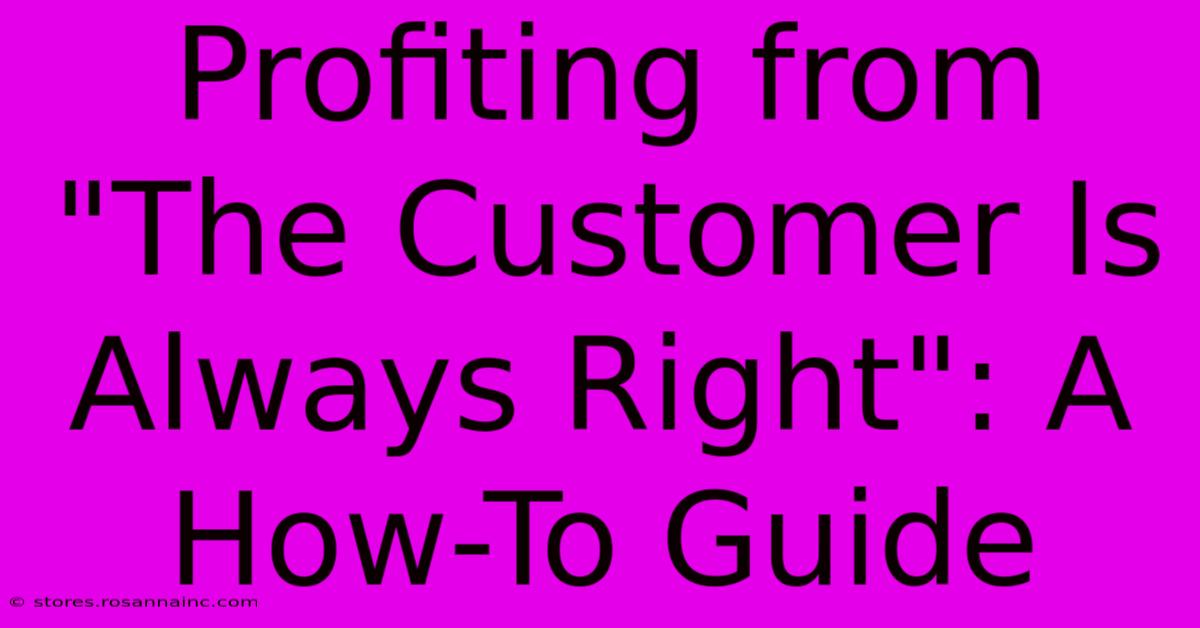Profiting From "The Customer Is Always Right": A How-To Guide

Table of Contents
Profiting from "The Customer Is Always Right": A How-To Guide
The adage, "The customer is always right," isn't about blindly accepting every complaint; it's about strategically leveraging customer feedback to boost profits. While sometimes challenging, mastering this approach transforms dissatisfaction into opportunities for growth and increased revenue. This guide will show you how.
Understanding the True Meaning
Before diving into strategies, let's clarify: "The customer is always right" doesn't mean you're wrong. It means customer perception is reality. Even if a customer is factually incorrect about a product's function or a company's policy, their feeling of being wronged needs addressing. Focusing on their experience, understanding their perspective, and resolving their issue is key to profitability.
Why is Customer Satisfaction Crucial for Profit?
- Increased Customer Lifetime Value (CLTV): Happy customers become repeat customers, spending more over time.
- Positive Word-of-Mouth Marketing: Satisfied customers organically promote your business through referrals and online reviews.
- Reduced Customer Churn: Addressing issues promptly and effectively prevents customers from switching to competitors.
- Valuable Feedback: Constructive criticism from unhappy customers provides invaluable insights for product improvement and service enhancements.
- Stronger Brand Reputation: A reputation for excellent customer service builds trust and attracts new customers.
Turning Complaints into Profits: Actionable Strategies
Now, let's explore actionable steps to transform negative customer experiences into positive outcomes.
1. Establish Efficient Complaint Channels
Make it easy for customers to voice concerns. This includes:
- Multiple Contact Options: Offer phone, email, live chat, and social media support.
- Clear and Accessible Contact Information: Prominently display contact information on your website and marketing materials.
- Fast Response Times: Aim to respond to inquiries within 24 hours, ideally sooner.
2. Empower Your Employees to Resolve Issues
Equip your customer service team with the authority to:
- Offer immediate solutions: Don't make customers jump through hoops to get help.
- Provide compensation: Offer discounts, refunds, or replacements to appease dissatisfied customers.
- Gather feedback: Actively solicit feedback to understand the root cause of the issue.
3. Actively Listen and Empathize
When dealing with a complaint, remember these crucial steps:
- Listen attentively: Let the customer fully explain their issue without interruption.
- Show empathy: Acknowledge their frustration and validate their feelings.
- Avoid defensiveness: Don't argue with the customer or try to justify your actions.
4. Turn Negative Feedback into Positive Change
Analyze customer complaints to identify recurring issues. This data-driven approach reveals areas needing improvement:
- Product Development: Use feedback to refine existing products or develop new ones.
- Process Improvement: Streamline processes to prevent future issues from arising.
- Training and Development: Improve employee training to enhance customer service skills.
5. Leverage Positive Reviews and Testimonials
Showcase positive customer experiences to build trust and attract new clients. This can be done through:
- Website Testimonials: Feature positive reviews prominently on your website.
- Social Media Marketing: Share positive customer feedback on your social media channels.
- Case Studies: Create case studies that highlight successful customer interactions.
Beyond the Transaction: Building Customer Loyalty
Profiting from customer satisfaction goes beyond simply resolving complaints. It’s about fostering long-term relationships:
- Personalized Communication: Tailor your communication to individual customer needs and preferences.
- Loyalty Programs: Reward repeat customers with exclusive discounts and benefits.
- Proactive Customer Service: Reach out to customers proactively to address potential issues before they arise.
By embracing a customer-centric approach, turning complaints into learning opportunities, and nurturing customer relationships, you can transform the "customer is always right" philosophy from a potential cost center into a powerful profit engine. Remember, happy customers are your most valuable asset.

Thank you for visiting our website wich cover about Profiting From "The Customer Is Always Right": A How-To Guide. We hope the information provided has been useful to you. Feel free to contact us if you have any questions or need further assistance. See you next time and dont miss to bookmark.
Featured Posts
-
The Truth Behind El Blog Del Narco Myths Vs Reality
Feb 10, 2025
-
Solving The Social Contract Puzzle Exploring The Works Of Thomas Hobbes
Feb 10, 2025
-
Rugby Irlande S Impose En Ecosse
Feb 10, 2025
-
Super Bowl Anthem The Singer
Feb 10, 2025
-
Batistes Super Bowl 2025 Anthem Length
Feb 10, 2025
